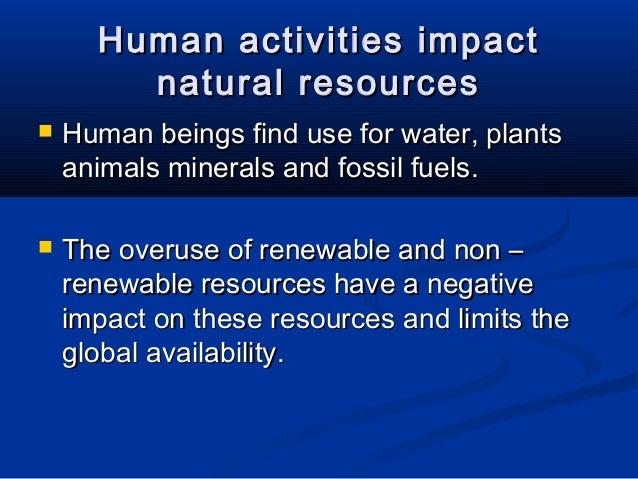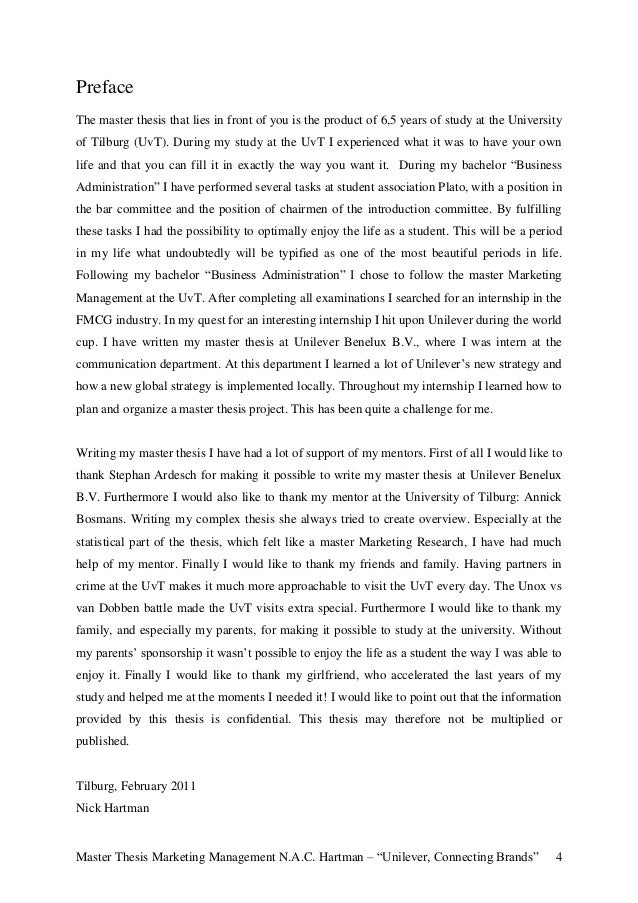
While these are all natural processes, much of the change that we are currently observing is due to human activity. For example, emissions from cars, planes, and power plants put large amounts of Dec 27, · Human activities such as burning fossil fuels and biomass contribute to emissions of these substances, although some aerosols also come from natural sources such as volcanoes and marine plankton. Black carbon (BC) is a solid particle or aerosol, not a gas, but it also contributes to warming of the atmosphere Examples of Natural Disasters. Before we begin, let’s look at some examples of natural disasters. This will help set the tone for the rest of the module and give an understanding of some of the sorts of scenarios we’ll be studying. The four examples presented here are four of the biggest natural
Examples of Natural Disasters | GEOG 30N: Environment and Society in a Changing World
Humans, animals, and other living organisms have relied on natural resources for survival since the beginning of time. The conservation of natural resources is important as the world population continues to grow, with many of the most important effect of human activities on natural resource resources being finite and non-renewable, effect of human activities on natural resource.
Natural resources are materials and substances that occur naturally and can be used for economic gain. They include minerals, forests, fertile land, and water.
Some natural resources, such as soil and water, are essential for the existence of life. A non-renewable natural resource is defined as a resource that cannot be replaced in our lifetime. They include metal ores, fossil fuels, earth minerals, and in some certain situations groundwater.
Renewable natural resources are resources that can be replaced naturally in our lifetime, and used repeatedly.
Examples include freshwater, timber, oxygen, and solar energy. Natural resources are a non-renewable and invaluable ingredient in the modern world. A natural resource is anything we use to provide fulfillment to our needs such as minerals, oil, effect of human activities on natural resource, water, gases and metals. In fact, natural resources can be anything consumed to survive as well such as animals fish, insects, cows, effect of human activities on natural resource, chicken etc and plants.
As renewable resources come with limitations for their production and usage for material consumption — often due to environmental factors — it is important to be conscientious of their availability so they can continue to meet demand for supply. Copper has been in use for thousands of years and is one of the first metals ever used by man. It occurs naturally and is one of the few metallic elements effect of human activities on natural resource occur in effect of human activities on natural resource form.
The majority of copper is used in electrical wires, industrial machinery, and roofing and plumbing. Copper is also used in nutritional supplements and fungicides for agriculture. The United States is the second largest producer of copper, which is mined from copper ores and recovered through recycling. Copper can be recycled without any loss in quality.
As a result nearly just as much copper is recovered through recycling as is derived from newly mined ore. According the Royal Society of Chemistry helium is necessary as a cooling medium for the Large Hadron Collider LHCsuperconducting magnets in MRI scanners and NMR spectrometers, and satellite instruments.
Because helium is non-reactive it is used to create a protective inert atmosphere in the processes of making fiber optics and semi-conductors. Helium is also used to detect leaks in air-conditioning systems, and to inflate air-bags in vehicles because it is non-toxic and diffuses quickly. Even though helium is the second most abundant element in the solar system, it is considered a non-renewable resource. Extracting helium from the air is uneconomical with there being less than 0. Bauxite forms as rocks in soils with very little soluble materials that are located in wet tropical climates.
This is one of the reasons why Australia is the top producer of bauxite. Bauxite is the main ingredient in making aluminum metal, and nearly all aluminum produced has been extracted from bauxite. It is also used in hydraulic fracturing, a process in drilling for oil and gas. This is why it is used to make steel, electrical wiring and conduct, pipes, tools, hinges, door handles, stoves, pots and pans, and even sofa frames. People have been using coal as a heat source for centuries.
Coal is a fossil fuel created through a process known as coalification. Plants that formed millions of years ago in swamp forests died and formed layers of peat that were buried through geological processes, and then altered through heat and pressure in low oxygen environments. There are many problems that accompany the mining and use of coal. According to the U. Geological Surveyone of the more serious environmental issues is the adverse effect on surface and ground water from the disposal of ash and sludge that results from the burning of coal and the cleaning of flue gases.
It is also used in the process of making plastics and other commercially important organic compounds. Natural gas is a fossil fuel created by the decomposition of organic material, usually from ancient marine organisms, in an anaerobic environment. There are two categories of natural gas deposits, conventional and unconventional. Conventional deposits are associated with oil reserves, and unconventional deposits include coal bed methane, shale gas, and tight-gas sandstone.
Like natural gas, oil is created through the decomposition of organic matter in an anaerobic environment over millions of years. Oil is also used in the manufacturing of petrochemicals for production of plastics, synthetic rubber, and chemicals. The location of oil and gas reserves is determined by plate tectonics. This is why most oil is found in deserts, artic regions, river deltas, and continental margins offshore.
Plate tectonics create the locations for anoxic burial and the high pressure effect of human activities on natural resource heat required for organic matter to turn to oil. Salt is mined through one of four methods: rock salt mining underground, solution mining by injecting a solvent that dissolves underground salt and then is recovered through solar evaporations, sea water evaporation in which sea water is collected in solar evaporation ponds, and inland solar evaporation which is similar to sea water evaporation but inland.
Timber is an important renewable natural resource in many societies around the world. If production is approached in a responsible way it can be both sustainable and economical. Timbers are mostly used to create lumber for use in construction. They can also be roughly shaped and used as heavy duty beams and columns. Timber is also used to make paper products, fiber board, hard board, effect of human activities on natural resource, plywood, and particle board. Soil is one of the most important natural resources on Earth, being required both directly and indirectly for food production, manufacturing of industrial raw materials, effect of human activities on natural resource, and for generation of energy sources.
Soil is essential for the function of ecosystems providing nutrients, oxygen, effect of human activities on natural resource, water, and heat. Soil resources are being degraded by poor effect of human activities on natural resource practices and chemical contamination.
One of the most significant challenges facing current and future generations is the preservation of this irreplaceable natural resource from pollution and physical destruction. Like soil, water is one of the most important natural resources for the existence of life.
Fresh water is considered a renewable resource, but most of the water humans drink comes from groundwater sources that are being depleted faster than they can be replenished. Even though water is considered a renewable resource, water resources are facing serious threats by human activities.
These activities include pollution, urban growth, deforestation, and climate change. Natural resources are essential to civilization as we know it, and are the basis for economy and survival.
Resources such as bauxite, iron, and copper form the basis of everyday items, while water, soil, and salt are required for life.
Some things you can do in your everyday life to conserve natural resources include recycling plastic, paper, and metal, and using energy more efficiently. Do you have any ideas on how to conserve and protect natural resources?
Please let us know by leaving a comment. Featured Image Credit: Nicolas Raymond Flickr. A List of the Top 11 Natural Resources Examples — Renewable and Non-Renewable by Ecavo. com Environment. previous What Is Urban Sprawl? next What Is El Niño?
How long will human impacts last? - David Biello
, time: 5:30TOP 11 Natural Resource Examples (Renewable & Nonrenewable)
While these are all natural processes, much of the change that we are currently observing is due to human activity. For example, emissions from cars, planes, and power plants put large amounts of Examples of Natural Disasters. Before we begin, let’s look at some examples of natural disasters. This will help set the tone for the rest of the module and give an understanding of some of the sorts of scenarios we’ll be studying. The four examples presented here are four of the biggest natural Dec 27, · Human activities such as burning fossil fuels and biomass contribute to emissions of these substances, although some aerosols also come from natural sources such as volcanoes and marine plankton. Black carbon (BC) is a solid particle or aerosol, not a gas, but it also contributes to warming of the atmosphere

No comments:
Post a Comment